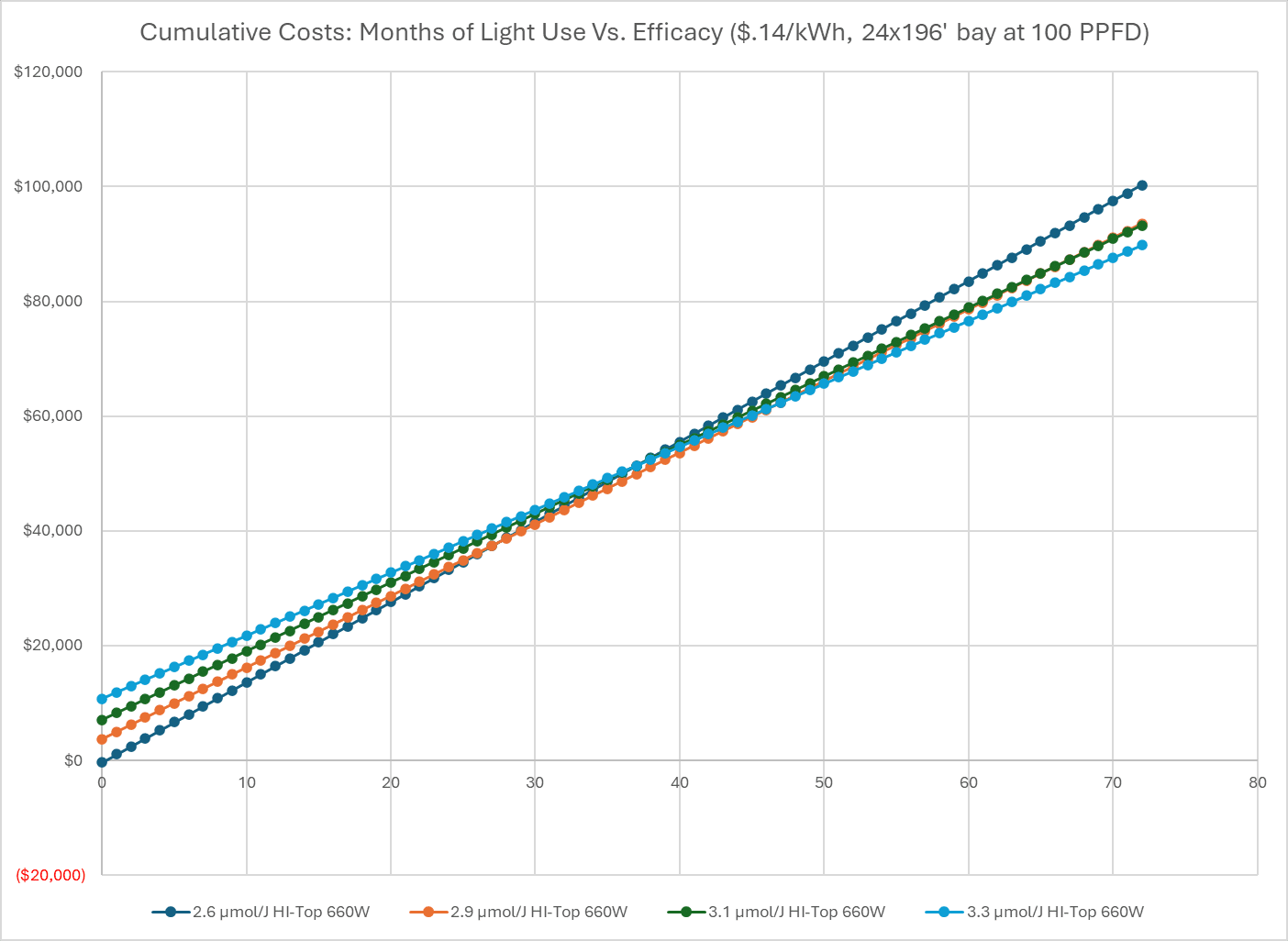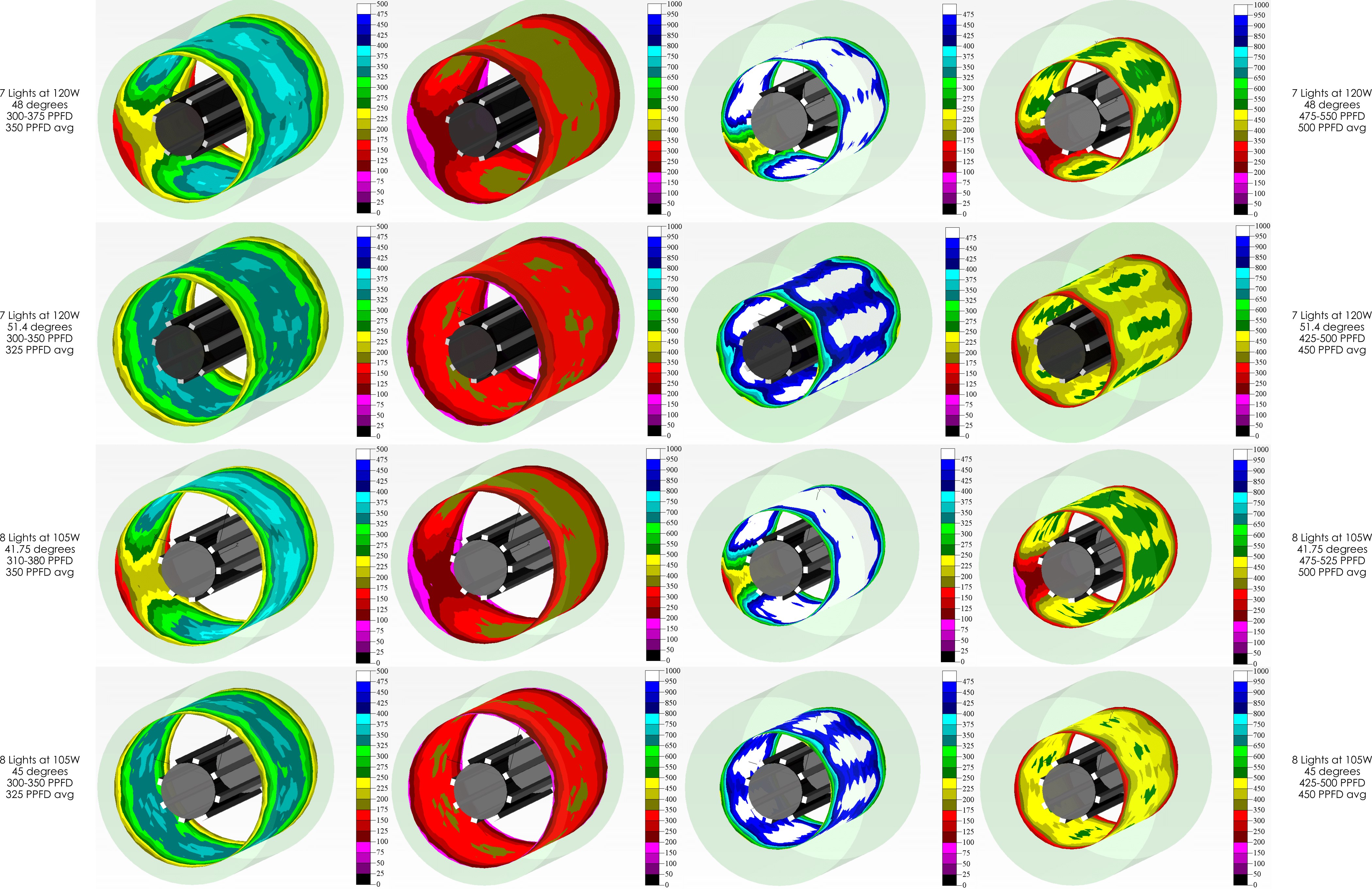Key Takeaways
- Multiple options available: LED grow lights have varying efficacies that come with varying costs. Increasing efficacy increases product cost.
- Total cost matters: It's crucial to consider total cumulative costs (initial + operating) when comparing lights.
- Incentives factor in: Many utilities offer energy efficiency incentives, but their calculation methods vary and may be best utilized by different lights.
- Lower efficacy can be best: An LED light with a good, but not maximum, efficacy and a lower upfront cost is often best for growers with limited light usage/shorter grow seasons, and may still qualify for utility incentives. Some incentive programs will end up covering these costs better than higher efficacy lights.
- Higher efficacy options exist: Higher efficacy, higher cost models gain more attractive ROIs if power costs are high, and/or annual hours of operation are high. Some incentives factor in efficacy more strongly and may cover costs better for higher efficacy lights.
Recent conversations within the growing community have raised questions regarding the trade-off between upfront cost and operational efficiency. Today, we aim to move beyond rumors and oversimplifications and shed light on the facts, providing a data-driven analysis within the context of greenhouse grower’s energy landscape.
We understand the importance of making informed decisions, especially when it comes to lighting, a major contributor to both yield and operational costs. Let's address the elephant in this room – efficiency vs. total cost of ownership (TCO).
The Incentive Landscape
In a multitude of states, growers are currently fortunate enough to enjoy access to significant lighting incentives. Some of these incentives are based on the total LED lighting power installed, not solely on power reduction, as long as the lights meet several strict efficacy, reliability, and safety standards. This creates a unique opportunity to leverage strategically chosen lights for maximum financial benefit, giving you a competitive advantage in the market.
This is where an LED light with varying efficacy models (2.6-3.3 µmol/J) can allow you to optimize your TCO based on your specific circumstances.
Strategy Over Pure Power
A light with a 2.6 µmol/J efficiency rating may not top the charts, but the following analysis will reveal its unique value proposition within greenhouse markets, especially considering the cost leadership strategy it offers. This “lower” efficacy level LED still produces 50%+ more light per watt than most types of HPS lights.
Though a minority of utility incentive programs require higher efficacies, this moderately high efficiency lighting approach strikes a perfect balance for many situations of qualifying for incentives that have the opportunity to value 100% of the lighting equipment costs, which translates to drastic upfront cost savings. This can be crucial in a competitive market, where margins and cash flow are often tight. While it might consume slightly more power compared to higher-efficiency options, remember, we're talking about TCO, not just raw numbers.
ROI Reigns Supreme
Let's crunch some numbers with a realistic scenario: a 24×196 bay, $.14/kWh electricity, competitive light pricing, and 18 hours/day usage. The results are clear:
- A lower-cost light like the 2.6 µmol/J TotalGrow HI-Top 660W boasts the lowest TCO until 28 months of light use, which is typically several years of operating for most greenhouse growers.
- For common usage patterns (3-4 months/year), it takes 7-9 years for a higher-efficiency model to pay back its initial cost difference. These premium price models therefore aren’t the most competitive choice given the use case outlined above.

Our analysis suggests that, for a significant portion of greenhouse growers, the combined savings from the utility incentive and lower upfront cost of the 2.6 µmol/J light may outweigh the slightly higher operating expenses.
Situational variables that can change this conclusion include:
- Higher electrical costs will make the higher-efficacy ROI more rapid.
- Some facilities have limited total power availability, and higher efficacy lights will allow higher light intensities for greater yields.
- A minority of incentive programs require or reward even higher efficacy levels.
- Higher annual hours of use will reduce the ROI.
- In some cases higher efficacies to further reduce power demand will further reduce electrical infrastructure/installation costs.
Ultimately, choosing the optimal grow light solution requires careful consideration of individual needs and financial priorities. The lower implementation cost, moderately high efficacy lights may allow broader implementation–improving more yields, revenue, and other profit-increasing aspects of the business–than over-investing in a smaller area due to budget limitations.
ROI-Focused Lighting Solutions
Whether you're in the US or abroad, we prioritize your success, and often, that means suggesting a lower-cost option if it leads to a faster and higher ROI in your specific context.


Work with an experienced and well-equipped lighting partner that is in your corner, analyzing, strategizing, and innovating to ensure your grow room or greenhouse shines bright, both figuratively and financially, meticulously assessing your specific needs and presenting all relevant data, enabling you to determine the ROI for your unique variables.
For general/initial guidance and options on your own, put our TotalGrow Lighting Planner and Calculator to use. After use, provide us with details of your application to unlock the full potential of your growing operation with our support.
This article is a contribution from TotalGrow, it is not a sponsored article.


